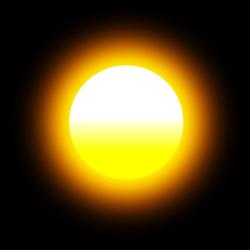Source Institutions
Source Institutions
Add to list Go to activity
Activity link broken? See if it's at the internet archive

In this math activity related to light, learners assemble a photometer and use it to estimate the power output of the Sun. Learners construct the photometer by making a grease spot on white paper and compare the brightness of the Sun to the brightness of a lamp. Learners calculate the power output by identifying the position at which the Sun is as bright as the lamp. This resource guide includes a calculation example and explains three complications that arise in this experiment. Instructions for constructing a plastic photometer are also provided.
- Under 5 minutes
- 10 to 30 minutes
- 1 cent - $1 per student
- Ages 14 - 18
- Activity, Experiment/Lab Activity
- English
Quick Guide
Materials List (per student)
- Sun
- Piece of white typing paper 10 cm square or lareger
- Drop of cooking oil
- Meterstick
- A 200 Watt lightbulb and lamp to hold it
- (Optional) Two pieces of translucent white plastic at least 2.5 cm (1 inch) square
- (Optional) Aluminum foil the same size as the plastic
- (Optional) Transparent tape or a rubber band
Subjects
-
Earth and Space Science
- Earth Structure
- Earth, Moon and Sun
-
Solar System
- The Sun
-
Engineering and Technology
-
Engineering
- Environmental Engineering
- Technology
-
Engineering
-
Physical Sciences
- Energy
-
Vibration and Waves
- Light and Optics
-
Light and Optics
- Sunlight and Color
-
Life Sciences
-
Human Senses and Perception
- Vision
-
Human Senses and Perception
-
Mathematics
-
Algebra
- Equations and Inequalities
-
Data Analysis and Probability
- Data Analysis
- Data Collection
-
Measurement
- Circles
-
Number and Operations
- Exponents
-
Algebra
-
The Nature of Technology
-
The Design Process
- Troubleshooting and Maintenance
-
The Design Process
-
The Nature of Science
-
The Scientific Process
- Conducting Investigations
- Gathering Data
-
The Scientific Process
Informal Categories
- Nature and Environment
- Outdoor Activity
Audience
To use this activity, learners need to:
- see
- see color
- read
- touch
Learning styles supported:
- Involves hands-on or lab activities
Other
This resource is part of:
Access Rights:
- Free access
By:
- Doherty, Paul
Rights:
- All rights reserved, The Exploratorium,
Funding Sources:
- National Science Foundation
- California Department of Education
- NEC Foundation of America
